Isaac McCoy and Wig: Difference between pages
m gbooks-author |
Undid revision 245092755 by Warrington (talk) per WP:BLP you can't imply she's wearing a wig without a source. |
||
| Line 1: | Line 1: | ||
{{otheruses|wig (disambiguation)}} |
|||
'''Isaac McCoy''' ([[June 13]][[1784]]-[[June 21]][[1846]]) was a [[Baptist]] [[missionary]] among the [[Native Americans in the United States|Native Americans]] who was to play an instrumental role in the founding of [[Grand Rapids, Michigan]] and [[Kansas City, Missouri]]. |
|||
[[Image:Wigs on display.jpg|right|thumb|250px|Modern wigs on display.]] |
|||
==Early life== |
|||
McCoy was born in [[Uniontown, Pennsylvania]]. He married Christiana Polk, a cousin of President [[James K. Polk]], in 1803. In 1804 they moved to [[Clark County, Indiana]]. In 1808 the Silver Creek Baptist Church granted him a license "to preach the Gospel wherever God in His providence might cast his lot.”<ref>[http://www.rootsweb.com/~incccpc/clarkbios/mccoy-isaac.html Roots Web Site]</ref> |
|||
A '''wig''' is a head of [[hair]] made from horse-hair, human hair, wool, feathers, buffalo hair, or synthetic, worn on the head for fashion or various other aesthetic and stylistic reasons, including cultural and religious observance. The word wig is short for '''periwig''' and first appeared in the [[English language]] around 1675. |
|||
In 1809 they relocated to [[Knox County, Indiana]], near [[Vincennes, Indiana]], where he became pastor of Maria Creek Church. In 1817 he was assigned to be a missionary to the [[Miami Indians]] living on the [[Wabash River]] above [[Terre Haute, Indiana]]. |
|||
Some people wear wigs to disguise the fact that they are [[baldness|bald]]. [[Actor]]s, on the other hand often wear costume wigs in order to better portray the [[fictional character|character]] they are playing. |
|||
In 1822 he established the [[Carey Mission]] among the [[Pottawatomie]] on the [[St. Joseph River]] near [[Niles, Michigan]]. In 1826 he founded the Thomas Mission among the [[Ottawa (tribe)|Ottawa]] at what is today [[Grand Rapids, Michigan]]. He was to be the first white settler in Niles and Grand Rapids. |
|||
With good intentions, he was an early proponent of moving the eastern Native American tribes to available land in The West. He believed that getting the tribes their own, isolated places, away from the reach of those white men that were exploiting them, would give them a better chance of surviving — and becoming good Christians. Unfortunately, the result was the great [[Indian removal]] that included the Trail of Tears. |
|||
==History== |
|||
==Missionary work in Kansas City== |
|||
[[Image:Ex-voto a sainte-genevieve -Detail-Largilliere.jpg|thumb|right|225px|Wigs 1700th century]] |
|||
Following the [[Indian Removal Act]] of 1830, McCoy, his son [[John Calvin McCoy|John]], his daughter Deliah and her missionary husband Johnston Lykins accompanied the [[Shawnee (tribe)|Shawnee]] as they moved to what is now [[Kansas City, Missouri]], which was on the border of Indian territory in Kansas. The younger McCoy established a trading post at [[Westport, Kansas City|Westport, Missouri]], and was among the first organizers of Kansas City. Lykins became one of the city's first mayors. |
|||
[[Image:Pierre van schuppen-Largilliere.jpg|right|thumb|220px|Pierre van Schuppen]] |
|||
In 1840, he wrote one of the earliest, most personally informed reports on the midwestern tribes, ''The History of Baptist Indian Missions''. In 1842 he moved to [[Louisville, Kentucky]], where he became director of the Baptist American Indian Mission Association and wrote. He died and is buried there in Western Cemetery. |
|||
[[Image:De Vermont-Largilliere.jpg|right|thumb|220px|Nicolas de Vermont]] |
|||
[[Image:George IV of the United Kingdom.jpg|right|thumb|250px|George IV (born in 1762), wore an auburn wig for his coronation in 1821 and this official portrait by Sir [[Thomas Lawrence (painter)|Thomas Lawrence]]]] |
|||
[[Image:Elizabeth I (Armada Portrait).jpg|right|thumb|250px|Queen [[Elizabeth I of England|Elizabeth I]], pictured in 1588.]] |
|||
Wigs have been worn throughout history, even on the genitals (see [[merkin]]). |
|||
The [[Ancient Egypt|ancient]] [[Egyptians]], wore them to shield their shaved, hairless heads from the sun. Other ancient cultures, including the [[Assyrians]], [[Phoenicians]], [[Ancient Greeks|Greeks]] and [[ancient Rome|Romans]], also used wigs. Wigs are principally a Western form of dress — in the [[Far East]] they have rarely been used except in the traditional [[theatre]] of [[China]] and [[Japan]]. Some East Asian entertainers (Japanese [[Geisha]], Korean [[Kisaeng]]) wore wigs ([[Katsura]] and [[gache]] respectively) as part of their traditional costumes. After the [[fall of the Roman Empire]], the use of wigs fell into abeyance in the West for a thousand years until revived in the 16th century as a means of compensating for hair loss or improving one's personal appearance. They also served a practical purpose: the unhygienic conditions of the time meant that hair attracted [[head lice]], a problem that could be much reduced if natural hair were shaved and replaced with a more easily de-loused artificial hairpiece. Fur hoods were also used in a similar preventative fashion. |
|||
Royal patronage was crucial to the revival of the wig. Queen [[Elizabeth I of England]] famously wore a red wig, tightly and elaborately curled in a "Roman" style while King [[Louis XIII of France]] (1601-1643) and King [[Louis XIV of France]] (1638-1715) pioneered wig-wearing among men from the 1620s onwards. |
|||
King [[Louis XIV of France]] was also popularly known as The Sun King (in French "Le Roi Soleil"). During his reign he built the [[Château de Versailles]], a large and extravagant royal residence and moved there the court life from [[Paris]]. He created an elaborate court style at [[Versailles]]. King [[Louis XIV]] was dictating men's fashion at the time with his sophisticated style, and his exuberant taste for luxury. <ref>[Das große Bilderlexikon der Mode – Vom Altertum zur Gegenwart, Artia Verlag, Prag 1966]</ref> |
|||
Perukes or periwigs for men were introduced into the English-speaking world with other [[France|French]] styles when [[Charles II of England|Charles II]] was restored to the throne in 1660, following a lengthy exile in France. These wigs were shoulder-length or longer, imitating the long hair that had become fashionable among men since the 1620s. Their use soon became popular in the English court. The London diarist [[Samuel Pepys]] recorded the day in 1665 that a [[barber]] had shaved his head and that he tried on his new periwig for the first time, but in a year of [[Black Death|plague]] he was uneasy about wearing it: |
|||
:''"[[September 3|3rd September]] 1665: Up, and put on my coloured [[silk]] suit, very fine, and my new periwig, bought a good while since, but darst not wear it because the plague was in [[Westminster]] when I bought it. And it is a wonder what will be the fashion after the plague is done as to periwigs, for nobody will dare to buy any haire for fear of the infection? that it had been cut off the heads of people dead of the plague."'' |
|||
Wigs were not without other drawbacks, as Pepys noted on [[27 March]] [[1667]]: |
|||
:''"I did go to the Swan; and there sent for Jervas my old periwig-maker and he did bring me a periwig; but it was full of [[Head louse|nit]]s, so as I was troubled to see it (it being his old fault) and did send him to make it clean."'' |
|||
With wigs becoming virtually obligatory garb for men of virtually any significant social rank, wigmakers gained considerable prestige. A wigmakers' guild was established in France in 1665, a development soon copied elsewhere in Europe. Their job was a skilled one as 17th century wigs were extraordinarily elaborate, covering the back and shoulders and flowing down the chest; not surprisingly, they were also extremely heavy and often uncomfortable to wear. Such wigs were expensive to produce. The best examples were made from natural human hair. The hair of horses and goats was often used as a cheaper alternative. |
|||
In the 18th century, men's wigs were powdered in order to give them their distinctive white or off-white color. Contrary to popular believe, women in the 18th century did not wear wigs, but wore a coiffure that we nowadays would call hair-extentions. The top of their natural hair was being enriched by fake hair, or hair not of their own. Women mainly powdered their hair grey, or blue-ish grey, and from the 1770's onwards never bright white like men. Wig powder was made from finely ground [[starch]] that was scented with orange flower, [[lavender]], or [[orris root]]. Wig powder was occasionally colored violet, blue, pink or yellow, but was most often used as off-white. Powdered wigs (men) and powdered natural hair with extentions (women) became an essential for full dress occasions and continued in use until almost the end of the 18th century. Powdering wigs and extentions was messy and inconvenient and the development of the naturally white or off-white powderless wig (made of horsehair) for men is no doubt what has made the retention of wigs in everyday [[court dress]] a practical possibility. By the 1780s, young men were setting a fashion trend by lightly powdering their natural hair, like women already did from the 1770's onwards. Often they would use their own hair and not a wig. After 1790, both wigs and powder were reserved for older more conservative men, and were in use by ladies being presented at court. After 1790 women hardly powdered their hair anymore. In 1795, the English government levied a tax of hair powder of one guinea per year. This tax effectively caused the demise of both the fashion for wigs and powder by 1800. |
|||
[[Image:Marie-Antoinette; koningin der Fransen.jpg|thumb|250px|[[Marie Antionette]] wearing the distinctive ''pouf'' style coiffure: her own natural hear is being extended on the top by fake hair. However, strictly speaking, this is not a wig and contrary to popualr belive Marie-Antoinette never wore wigs.]] |
|||
[[Image:William Hogarth 004.jpg|thumb|250px|[[William Hogarth]]: ''[[The Bench (Hogarth)|The Bench]]'', 1758]] |
|||
Among women in the French court of [[Versailles]] in the mid-to-late 18th century, large, elaborate and often themed (such as the stereotypical "boat poufs") were in vogue for women. These combed up hair-extentions were often very heavy, weighted down with pomades, powders, and other ornamentation. In the late 18th century these coiffures (along with many other indulgences in court life) became symbolic of the decadence of the French nobility, which helped to fuel the [[French Revolution]](although it's influence is highly exaggerated. |
|||
During the 18th century, men's wigs became smaller and more formal with several professions adopting them as part of their official costumes. This tradition survives in a few legal systems. They are routinely worn in various countries of the [[Commonwealth of Nations|Commonwealth]]. Until 1823, [[bishop]]s of the [[Church of England]] and [[Church of Ireland]] wore ceremonial wigs. The wigs worn by barristers are in the style favoured in the late eighteenth century. Judges' wigs are, in everyday use as [[court dress]], short like barristers' wigs (although in a slightly different style) but for ceremonial occasions judges and also senior barristers (QCs) wear full-bottomed wigs. |
|||
The wearing of wigs as a symbol of social status was largely abandoned in the newly created [[United States]] and France by the start of the 19th century, although it persisted a little longer in the United Kingdom. |
|||
Women's wigs developed in a somewhat different way. They were worn from the 18th century onwards - although at first only surreptitiously - and full wigs in the 19th and early 20th century were not fashionable. They were often worn by old ladies who had lost their hair. In the film ''[[Mr. Skeffington]]'' (1944), when [[Bette Davis]] has to wear a wig after a bout of [[diphtheria]], it is a moment of pathos and a symbol of her frailty. |
|||
== Current usage == |
|||
[[Image:Colourful wigs.jpg|thumb|250px|Colourful wigs for costume parties]] |
|||
In [[United Kingdom of Great Britain and Northern Ireland|Britain]] and most [[Commonwealth of Nations|Commonwealth]] nations, special wigs are also worn by [[barrister]]s, [[judge]]s, and certain [[parliament]]ary and municipal or civic officials as a symbol of the office. The original purpose of the legal wig was said to provide a form of anonymity and safety (i.e. disguise). Today, [[Hong Kong]] barristers and judges continue to wear wigs as part of [[court dress]] as an influence from their former jurisdiction of the [[Commonwealth of Nations]]. In July 2007, judges in [[New South Wales]], Australia voted to discontinue to wearing of wigs in the NSW Court of Appeal. <ref>[http://www.smh.com.au/news/national/woolly-headed-not-this-verdict/2007/08/02/1185648038982.html Woolly headed? Not this verdict - National - smh.com.au<!-- Bot generated title -->]</ref> New Zealand lawyers and judges have ceased to wear wigs except for special ceremonial occasions such as openings of Parliament or the calling of newly qualified [[barristers]] to the bar. |
|||
A number of celebrities, including [[Dolly Parton]] and [[Raquel Welch]] have popularized wigs. [[Cher]] has worn all kinds of wigs in the last 40 years- from blonde to black, and curly to straight. They may also be worn for fun as part of [[fancy dress]] ([[costume]] wearing), when they can be of outlandish colour or made from [[tinsel]]. They are quite common at [[Halloween]], when "rubber wigs" (solid [[bald cap]]-like hats, shaped like hair), are sold at some stores. |
|||
Orthodox Jewish religious law ([[Halakha]]) requires married women to cover her hair for reasons of modesty. Some women wear wigs, known as a [[sheitel]], for this purpose. |
|||
In [[Jidaigeki]], a genre of film and television, wigs are used extensively to alter the cast's hair styles to reflect the [[Edo Period]] when most stories take place. Only a few starring in big-budgeted films and television series will grow his or her hair so that it could be cut to a proper hair style instead of using a wig. |
|||
Wigs are used even on the [[theater]] and [[opera]] scenes. |
|||
Today, wigs are worn by some people on a daily or occasional basis in the everyday life, as a matter of convenience, since wigs can be styled ahead of time. They are also worn by individuals who are experiencing hair loss due to medical reasons (most commonly cancer patients who are undergoing [[chemotherapy]] or those who are suffering from [[alopecia areata]]). In men, the most common cause of baldness is "male-pattern baldness" and this is probably the most common reason for wig-wearing in this group. The post-menopausal diffuse baldness of women, while more common than generally realized, is usually not severe enough to warrant the wearing of a wig. |
|||
Another use seen in modern day society is for men who [[crossdress]] as women, wigs are used to make the men have more feminine hair in all sorts of styles, they wear this along with other 'female' clothing. |
|||
==Manufacture== |
|||
There are two major methods of wig manufacture currently in use, traditional and automated. The traditional method produces finer wigs and is used to produce customized wigs, particularly in film and theatrical productions. Machine made wigs are cheaper and are commonly found for novelty use. |
|||
===Measurement=== |
|||
Making customized wigs starts by taking measurements of the subject's head. Any existing hair is arranged into tight knots against the head and various measurements are taken. Sometimes a copy of the head is made by marking overtop clear plastic wrap placed over the scalp. This allows for the marking of the natural hairline. These measurements are then transferred to a ''wigform''.<ref name=howitsmade>{{cite episode |
|||
| title = Wigs |
|||
| series = How It's Made |
|||
| serieslink = How It's Made |
|||
| network = Discovery Channel Canada |
|||
| season = 6 |
|||
| seriesno = 6-06 |
|||
| number = 71 |
|||
}}</ref> |
|||
===Framework=== |
|||
A product called ''wig lace'' or sometimes ''wig netting'' is placed over the wigform. Wig lace is a fine lace comprised of polygonal cells. It can be made from natural or synthetic fibers. Finer lace is used on the edges to blend imperceptibly into the skin. Heavier lace is used towards the center to provide structual support. The lace is trimmed and sewn into the proper shape.<ref name=howitsmade/><ref name=stagemakeup>{{Cite book | author=Corson, Richard | title=Stage makeup | date=1990 | publisher=Prentice Hall | location=Englewood Cliffs, N.J. | isbn= 9780138405397}}</ref> |
|||
===Hair preparation=== |
|||
Hair used for wigs is assorted by length, color, and source (human, animal, synthetic). The wigmaker selects one or more sources of hair dependant on the intended wig design. The hair is then aligned on a device called a ''[[hackle (wig making)|hackle]]''. This serves straightens the hair so that individual strands may selected quickly and also separates out weaker strands which are left on the hackle. If multiple types of hair are selected, the process also serves to evenly mix the different varieties.<ref name=howitsmade/> |
|||
===Ventilation=== |
|||
The process of tying strands of hair onto the wig lace is known as ''ventilation''. The hair is folded in half so that strands may be plucked from their center. Wigmakers use a tool called a ''wig hook'' to select one or more stands of hair at a time to tie to the lace. The hook is specially bent to facilitate the tying of what is referred to as the ''ventilation knot''. This is effectively the same technique used in the construction of handmade rugs. Because the knot is tied from the midpoint of the strand, the source hair must be at least twice as long as the length of the completed wig; with extra length needed to account for styling. The wigmaker ties the hair onto specific edges of the individual lace cells in order to influence the grain of the wig. In the center of the wig, where high density is needed detail is obfuscated, multiple strands are tied at once. At the edges of the hairline, only one or two strands of hair are applied at a time.<ref name=howitsmade/><ref name=stagemakeup/> |
|||
===Styling=== |
|||
At this point, the hair on the wig is all the same length. The wig must be styled into the desired form in much the same manner as a regular stylist.<ref name=howitsmade/> |
|||
===Fitting=== |
|||
The subject's natural hair is again knotted tightly against the head and the wig is applied. Any remaining superfluous wiglace is trimmed away. Hairpins can be used to secure the lace to the hair and occasionally, skin-safe adhesives are used to adhere the wig against bald skin and to better hide any exposed lace. Finishing touches are done to the hair styling to achieve the desired effect.<ref name=howitsmade/> |
|||
==See also== |
|||
* [[Hair prosthesis]] |
|||
* [[Merkin]] |
|||
* [[Toupée]] |
|||
==External links== |
|||
* {{cite web |publisher= [[Cheap Wig Store]] |
|||
|url= http://www.cheapwigstore.com |
|||
|title= Showcasing various type of costume wigs, clown wigs, blond wigs, colors wigs, Afro wigs, etc...}} |
|||
* {{cite web |publisher= [[World Of Wigs]] |
|||
|url= http://www.worldofwigs.com |
|||
|title= Featuring high quality wigs, hairpieces and more!}} |
|||
==References== |
==References== |
||
{{reflist}} |
{{reflist}} |
||
*{{cite book|title=An Indian Canaan: Isaac McCoy and the Vision of an Indian State |first=George A. |last=Shultz|publisher=University of Oklahoma Press|id=ISBN 0-8061-1024-4|date=1972}} |
|||
[[Category:Wigs]] |
|||
==External links== |
|||
[[Category:Judicial clothing]] |
|||
*[http://www.kshs.org/research/collections/documents/personalpapers/findingaids/mccoy.htm The Isaac McCoy Papers at The Kansas Historical Society] |
|||
[[Category:Hairdressing]] |
|||
*{{gbooks-author}} |
|||
[[Category:History of clothing (Western fashion)]] |
|||
{{DEFAULTSORT:McCoy, Isaac}} |
|||
[[Category: |
[[Category:History of clothing (Europe)]] |
||
[[Category:1784 births]] |
|||
{{Link FA|zh}} |
|||
[[Category:1846 deaths]] |
|||
[[ru:Парик]] |
|||
[[Category:City founders]] |
|||
[[cs:Paruka]] |
|||
[[Category:People from Kansas City]] |
|||
[[de:Perücke]] |
|||
[[Category:People from Grand Rapids, Michigan]] |
|||
[[es:Peluca]] |
|||
[[Category:People from Indiana]] |
|||
[[eo:Peruko]] |
|||
[[Category:People from Louisville, Kentucky]] |
|||
[[fr:Perruque]] |
|||
[[Category:United States Indian agents]] |
|||
[[gd:Biorabhaig]] |
|||
[[ko:가발]] |
|||
[[is:Hárkolla]] |
|||
[[it:Parrucca]] |
|||
[[he:פאה נוכרית]] |
|||
[[nl:Pruik]] |
|||
[[ja:かつら (装身具)]] |
|||
[[no:Parykk]] |
|||
[[nds:Prüük]] |
|||
[[pl:Peruka]] |
|||
[[pt:Peruca]] |
|||
[[scn:Pilucca]] |
|||
[[simple:Wig]] |
|||
[[sk:Parochňa]] |
|||
[[sr:Перика]] |
|||
[[fi:Peruukki]] |
|||
[[sv:Peruk]] |
|||
[[tr:Peruk]] |
|||
[[yi:שייטל]] |
|||
[[zh:假髮]] |
|||
Revision as of 22:24, 13 October 2008

A wig is a head of hair made from horse-hair, human hair, wool, feathers, buffalo hair, or synthetic, worn on the head for fashion or various other aesthetic and stylistic reasons, including cultural and religious observance. The word wig is short for periwig and first appeared in the English language around 1675.
Some people wear wigs to disguise the fact that they are bald. Actors, on the other hand often wear costume wigs in order to better portray the character they are playing.
History


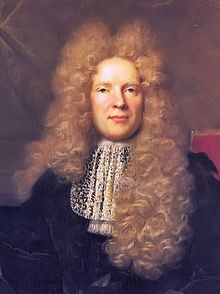
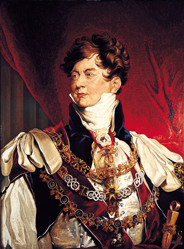
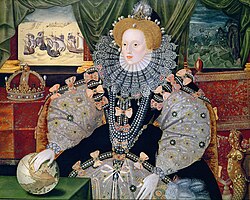
Wigs have been worn throughout history, even on the genitals (see merkin).
The ancient Egyptians, wore them to shield their shaved, hairless heads from the sun. Other ancient cultures, including the Assyrians, Phoenicians, Greeks and Romans, also used wigs. Wigs are principally a Western form of dress — in the Far East they have rarely been used except in the traditional theatre of China and Japan. Some East Asian entertainers (Japanese Geisha, Korean Kisaeng) wore wigs (Katsura and gache respectively) as part of their traditional costumes. After the fall of the Roman Empire, the use of wigs fell into abeyance in the West for a thousand years until revived in the 16th century as a means of compensating for hair loss or improving one's personal appearance. They also served a practical purpose: the unhygienic conditions of the time meant that hair attracted head lice, a problem that could be much reduced if natural hair were shaved and replaced with a more easily de-loused artificial hairpiece. Fur hoods were also used in a similar preventative fashion.
Royal patronage was crucial to the revival of the wig. Queen Elizabeth I of England famously wore a red wig, tightly and elaborately curled in a "Roman" style while King Louis XIII of France (1601-1643) and King Louis XIV of France (1638-1715) pioneered wig-wearing among men from the 1620s onwards. King Louis XIV of France was also popularly known as The Sun King (in French "Le Roi Soleil"). During his reign he built the Château de Versailles, a large and extravagant royal residence and moved there the court life from Paris. He created an elaborate court style at Versailles. King Louis XIV was dictating men's fashion at the time with his sophisticated style, and his exuberant taste for luxury. [1] Perukes or periwigs for men were introduced into the English-speaking world with other French styles when Charles II was restored to the throne in 1660, following a lengthy exile in France. These wigs were shoulder-length or longer, imitating the long hair that had become fashionable among men since the 1620s. Their use soon became popular in the English court. The London diarist Samuel Pepys recorded the day in 1665 that a barber had shaved his head and that he tried on his new periwig for the first time, but in a year of plague he was uneasy about wearing it:
- "3rd September 1665: Up, and put on my coloured silk suit, very fine, and my new periwig, bought a good while since, but darst not wear it because the plague was in Westminster when I bought it. And it is a wonder what will be the fashion after the plague is done as to periwigs, for nobody will dare to buy any haire for fear of the infection? that it had been cut off the heads of people dead of the plague."
Wigs were not without other drawbacks, as Pepys noted on 27 March 1667:
- "I did go to the Swan; and there sent for Jervas my old periwig-maker and he did bring me a periwig; but it was full of nits, so as I was troubled to see it (it being his old fault) and did send him to make it clean."
With wigs becoming virtually obligatory garb for men of virtually any significant social rank, wigmakers gained considerable prestige. A wigmakers' guild was established in France in 1665, a development soon copied elsewhere in Europe. Their job was a skilled one as 17th century wigs were extraordinarily elaborate, covering the back and shoulders and flowing down the chest; not surprisingly, they were also extremely heavy and often uncomfortable to wear. Such wigs were expensive to produce. The best examples were made from natural human hair. The hair of horses and goats was often used as a cheaper alternative.
In the 18th century, men's wigs were powdered in order to give them their distinctive white or off-white color. Contrary to popular believe, women in the 18th century did not wear wigs, but wore a coiffure that we nowadays would call hair-extentions. The top of their natural hair was being enriched by fake hair, or hair not of their own. Women mainly powdered their hair grey, or blue-ish grey, and from the 1770's onwards never bright white like men. Wig powder was made from finely ground starch that was scented with orange flower, lavender, or orris root. Wig powder was occasionally colored violet, blue, pink or yellow, but was most often used as off-white. Powdered wigs (men) and powdered natural hair with extentions (women) became an essential for full dress occasions and continued in use until almost the end of the 18th century. Powdering wigs and extentions was messy and inconvenient and the development of the naturally white or off-white powderless wig (made of horsehair) for men is no doubt what has made the retention of wigs in everyday court dress a practical possibility. By the 1780s, young men were setting a fashion trend by lightly powdering their natural hair, like women already did from the 1770's onwards. Often they would use their own hair and not a wig. After 1790, both wigs and powder were reserved for older more conservative men, and were in use by ladies being presented at court. After 1790 women hardly powdered their hair anymore. In 1795, the English government levied a tax of hair powder of one guinea per year. This tax effectively caused the demise of both the fashion for wigs and powder by 1800.
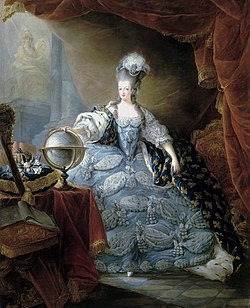
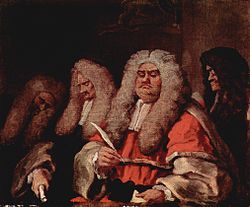
Among women in the French court of Versailles in the mid-to-late 18th century, large, elaborate and often themed (such as the stereotypical "boat poufs") were in vogue for women. These combed up hair-extentions were often very heavy, weighted down with pomades, powders, and other ornamentation. In the late 18th century these coiffures (along with many other indulgences in court life) became symbolic of the decadence of the French nobility, which helped to fuel the French Revolution(although it's influence is highly exaggerated.
During the 18th century, men's wigs became smaller and more formal with several professions adopting them as part of their official costumes. This tradition survives in a few legal systems. They are routinely worn in various countries of the Commonwealth. Until 1823, bishops of the Church of England and Church of Ireland wore ceremonial wigs. The wigs worn by barristers are in the style favoured in the late eighteenth century. Judges' wigs are, in everyday use as court dress, short like barristers' wigs (although in a slightly different style) but for ceremonial occasions judges and also senior barristers (QCs) wear full-bottomed wigs.
The wearing of wigs as a symbol of social status was largely abandoned in the newly created United States and France by the start of the 19th century, although it persisted a little longer in the United Kingdom.
Women's wigs developed in a somewhat different way. They were worn from the 18th century onwards - although at first only surreptitiously - and full wigs in the 19th and early 20th century were not fashionable. They were often worn by old ladies who had lost their hair. In the film Mr. Skeffington (1944), when Bette Davis has to wear a wig after a bout of diphtheria, it is a moment of pathos and a symbol of her frailty.
Current usage
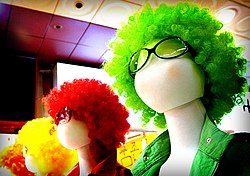
In Britain and most Commonwealth nations, special wigs are also worn by barristers, judges, and certain parliamentary and municipal or civic officials as a symbol of the office. The original purpose of the legal wig was said to provide a form of anonymity and safety (i.e. disguise). Today, Hong Kong barristers and judges continue to wear wigs as part of court dress as an influence from their former jurisdiction of the Commonwealth of Nations. In July 2007, judges in New South Wales, Australia voted to discontinue to wearing of wigs in the NSW Court of Appeal. [2] New Zealand lawyers and judges have ceased to wear wigs except for special ceremonial occasions such as openings of Parliament or the calling of newly qualified barristers to the bar. A number of celebrities, including Dolly Parton and Raquel Welch have popularized wigs. Cher has worn all kinds of wigs in the last 40 years- from blonde to black, and curly to straight. They may also be worn for fun as part of fancy dress (costume wearing), when they can be of outlandish colour or made from tinsel. They are quite common at Halloween, when "rubber wigs" (solid bald cap-like hats, shaped like hair), are sold at some stores. Orthodox Jewish religious law (Halakha) requires married women to cover her hair for reasons of modesty. Some women wear wigs, known as a sheitel, for this purpose.
In Jidaigeki, a genre of film and television, wigs are used extensively to alter the cast's hair styles to reflect the Edo Period when most stories take place. Only a few starring in big-budgeted films and television series will grow his or her hair so that it could be cut to a proper hair style instead of using a wig. Wigs are used even on the theater and opera scenes. Today, wigs are worn by some people on a daily or occasional basis in the everyday life, as a matter of convenience, since wigs can be styled ahead of time. They are also worn by individuals who are experiencing hair loss due to medical reasons (most commonly cancer patients who are undergoing chemotherapy or those who are suffering from alopecia areata). In men, the most common cause of baldness is "male-pattern baldness" and this is probably the most common reason for wig-wearing in this group. The post-menopausal diffuse baldness of women, while more common than generally realized, is usually not severe enough to warrant the wearing of a wig.
Another use seen in modern day society is for men who crossdress as women, wigs are used to make the men have more feminine hair in all sorts of styles, they wear this along with other 'female' clothing.
Manufacture
There are two major methods of wig manufacture currently in use, traditional and automated. The traditional method produces finer wigs and is used to produce customized wigs, particularly in film and theatrical productions. Machine made wigs are cheaper and are commonly found for novelty use.
Measurement
Making customized wigs starts by taking measurements of the subject's head. Any existing hair is arranged into tight knots against the head and various measurements are taken. Sometimes a copy of the head is made by marking overtop clear plastic wrap placed over the scalp. This allows for the marking of the natural hairline. These measurements are then transferred to a wigform.[3]
Framework
A product called wig lace or sometimes wig netting is placed over the wigform. Wig lace is a fine lace comprised of polygonal cells. It can be made from natural or synthetic fibers. Finer lace is used on the edges to blend imperceptibly into the skin. Heavier lace is used towards the center to provide structual support. The lace is trimmed and sewn into the proper shape.[3][4]
Hair preparation
Hair used for wigs is assorted by length, color, and source (human, animal, synthetic). The wigmaker selects one or more sources of hair dependant on the intended wig design. The hair is then aligned on a device called a hackle. This serves straightens the hair so that individual strands may selected quickly and also separates out weaker strands which are left on the hackle. If multiple types of hair are selected, the process also serves to evenly mix the different varieties.[3]
Ventilation
The process of tying strands of hair onto the wig lace is known as ventilation. The hair is folded in half so that strands may be plucked from their center. Wigmakers use a tool called a wig hook to select one or more stands of hair at a time to tie to the lace. The hook is specially bent to facilitate the tying of what is referred to as the ventilation knot. This is effectively the same technique used in the construction of handmade rugs. Because the knot is tied from the midpoint of the strand, the source hair must be at least twice as long as the length of the completed wig; with extra length needed to account for styling. The wigmaker ties the hair onto specific edges of the individual lace cells in order to influence the grain of the wig. In the center of the wig, where high density is needed detail is obfuscated, multiple strands are tied at once. At the edges of the hairline, only one or two strands of hair are applied at a time.[3][4]
Styling
At this point, the hair on the wig is all the same length. The wig must be styled into the desired form in much the same manner as a regular stylist.[3]
Fitting
The subject's natural hair is again knotted tightly against the head and the wig is applied. Any remaining superfluous wiglace is trimmed away. Hairpins can be used to secure the lace to the hair and occasionally, skin-safe adhesives are used to adhere the wig against bald skin and to better hide any exposed lace. Finishing touches are done to the hair styling to achieve the desired effect.[3]
See also
External links
- "Showcasing various type of costume wigs, clown wigs, blond wigs, colors wigs, Afro wigs, etc..." Cheap Wig Store.
- "Featuring high quality wigs, hairpieces and more!". World Of Wigs.
References
- ^ [Das große Bilderlexikon der Mode – Vom Altertum zur Gegenwart, Artia Verlag, Prag 1966]
- ^ Woolly headed? Not this verdict - National - smh.com.au
- ^ a b c d e f "Wigs". How It's Made. Season 6. Episode 71. Discovery Channel Canada.
{{cite episode}}: Unknown parameter|serieslink=ignored (|series-link=suggested) (help); Unknown parameter|seriesno=ignored (|series-number=suggested) (help) - ^ a b Corson, Richard (1990). Stage makeup. Englewood Cliffs, N.J.: Prentice Hall. ISBN 9780138405397.
